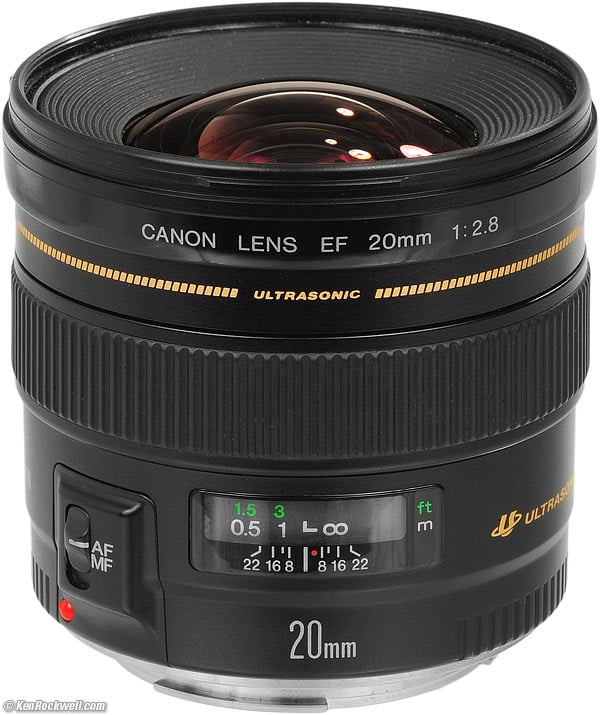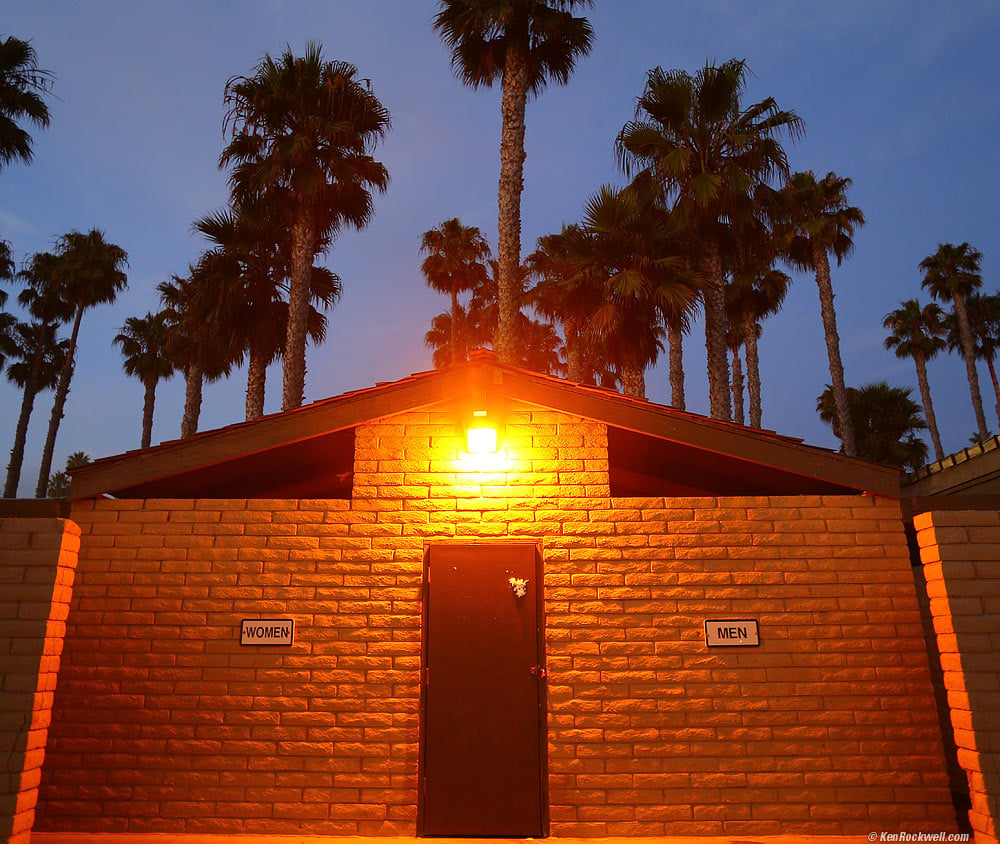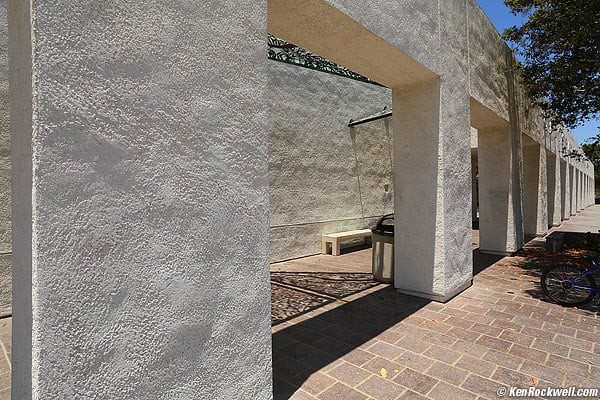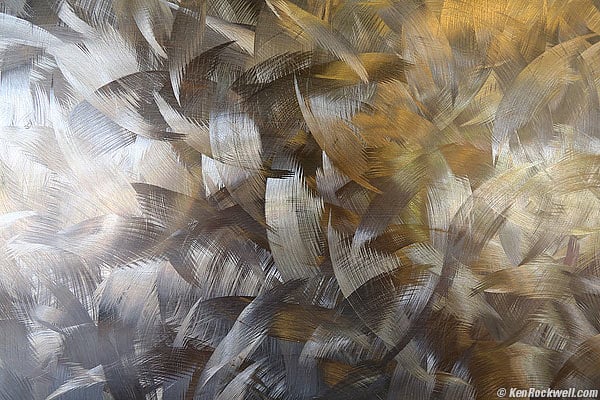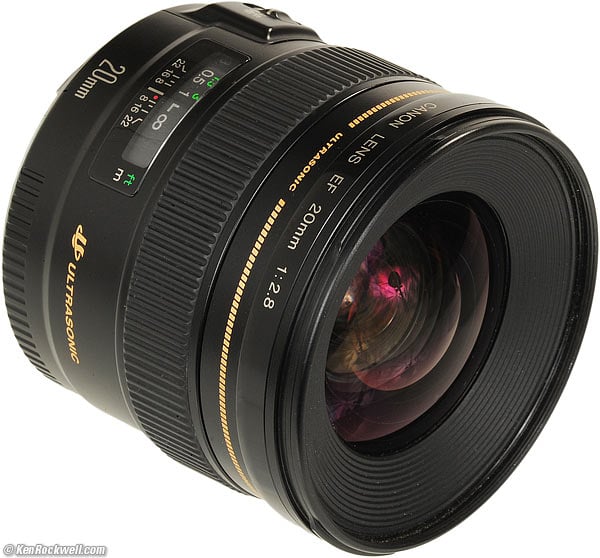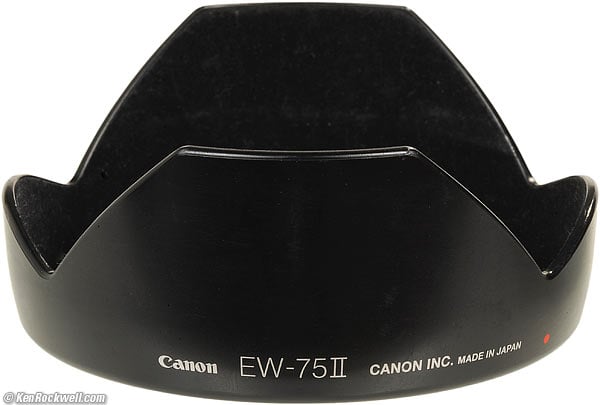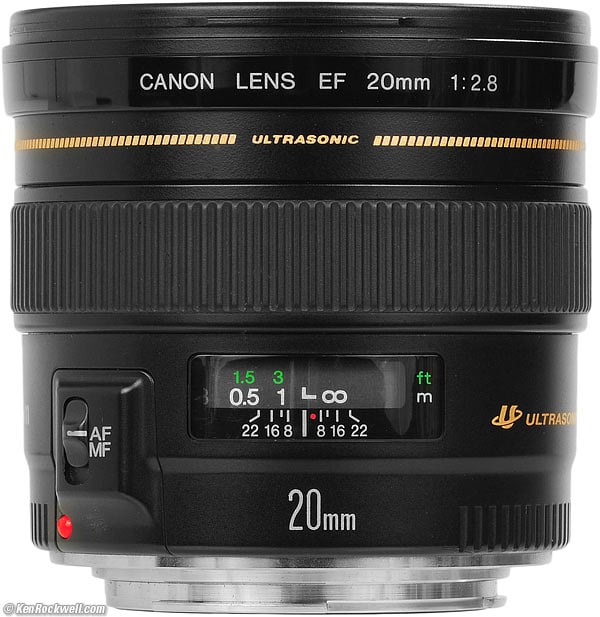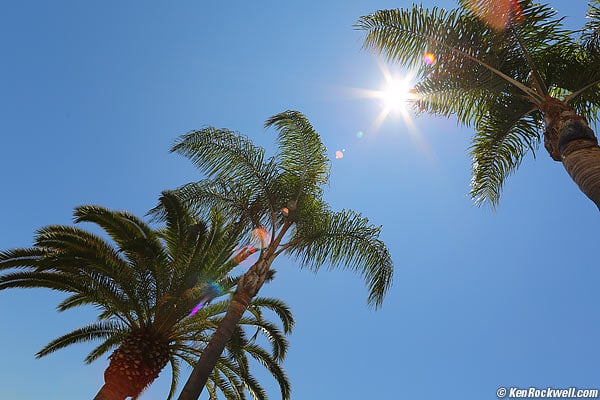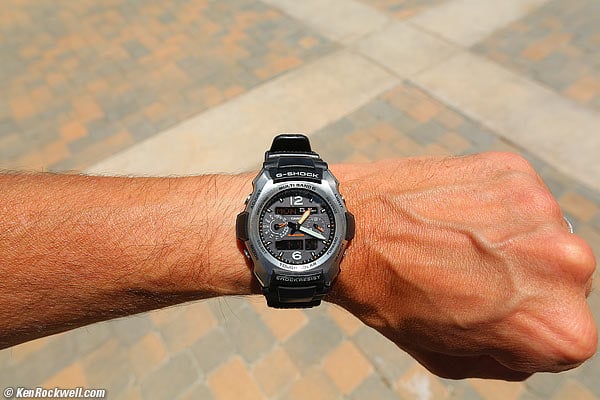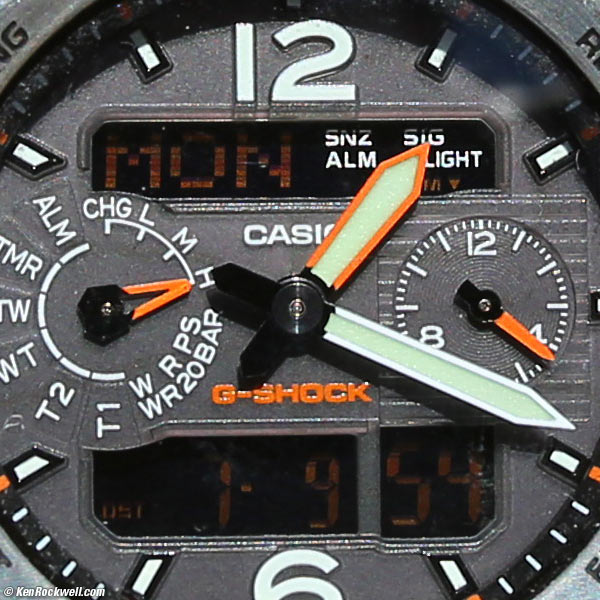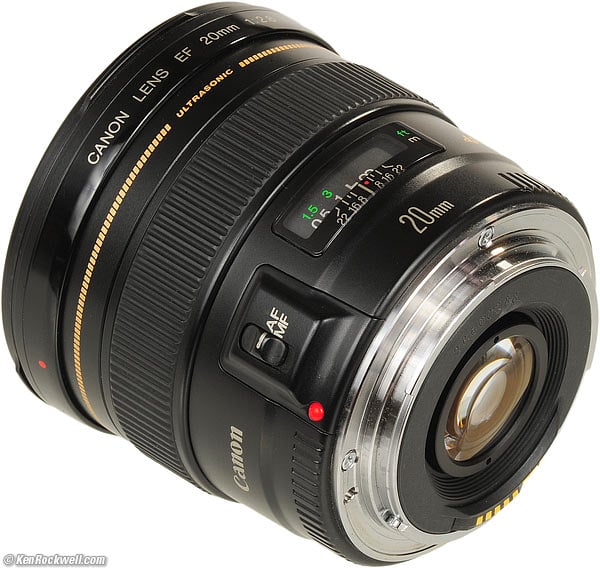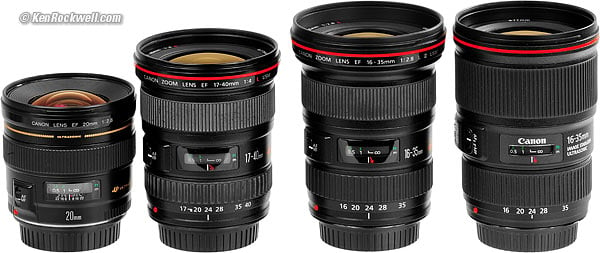Home Donate New Search Gallery Reviews How-To Books Links Workshops About Contact
Canon 20mm f/2.8 USM
EF Full-Frame (1992-today)
© 2012 KenRockwell.com. All rights reserved.
Intro Specs Performance Compared Recommendations More
Canon EF 20mm f/2.8 USM (72mm metal filter thread, 0.75'/0.23m close-focus, 13.9 oz./394g, about $500 new or $325 used.) enlarge. This free website's biggest source of support is when you use these links, especially these links directly to it at Adorama, at Amazon or at eBay (see How to Win at eBay), when you get anything, regardless of the country in which you live. Thank you! Ken.
July 2014 Canon Reviews Canon Lenses All Reviews
NEW: LEICA 21mm + Sony A7R II versus Canon 20mm USM + 5DS R Comparison 01 October 2015
NEW: Canon Ultrawide Lens Sharpness Comparison.
Canon Ultrawide Lenses Compared
Why fixed lenses take better pictures
Canon 16-35mm f/4 L IS (2014-today)
Canon 16-35mm f/2.8 L II (2007-today)
Canon 16-35mm f/2.8 L (2001-2007)
Canon 17-40mm f/4 L (2003-today)
Canon 17-35mm f/2.8 L (1995-2001)
Canon 20-35mm USM (1993-2007)
Canon 20mm f/2.8 USM (1992-today)
Canon 20-35mm f/2.8 L (1989-1995)
Tokina 17-35mm f/4 (2011-)
Sample Image Files
Toilet, San Clemente, August 2012. (Canon 5D Mark III, Canon EF 20mm f/2.8 USM, f/3.5 at 1/10 at ISO 400, hand-held.) bigger.
Library, July 2012. (Canon 5D Mark III, Canon 20mm f/2.8 USM, f/11 at 1/160, AUTO ISO 100, 6 sharpening, 0 saturation, AUTO WB A4.) Original © 7.4 MB file.
Macro: Brushed Metal at Only One Foot Away. (Canon 5D Mark III, Canon 20mm f/2.8 USM, f/11 at 1/30 hand held, AUTO ISO 1,000, 6 sharpening, +3 saturation, AUTO WB A4.) Original © 6.2 MB file.
Why Fixed Lenses Take Better Pictures
Canon Ultrawide Lenses Compared
Canon 16-35mm f/2.8 L II (2007-today)
Canon 16-35mm f/2.8 L (2001-2007)
Canon 17-40mm f/4 L (2003-today)
Canon 17-35mm f/2.8 L (1995-2001)
Canon 20-35mm USM (1993-2007)
Canon 20mm f/2.8 USM (1992-today)
Canon 20-35mm f/2.8 L (1989-1995)
Tokina 17-35mm f/4 (2011-)
Introduction top
Intro Specs Performance Compared Recommendations More
This Canon EF 20mm f/2.8 USM is Canon's only fixed autofocus ultrawide lens other than the 14mm f/2.8 L (1991-2007) and 14mm f/2.8 L II (2007-today). Canon has made this 20mm f/2.8 since 1992, so you can get a bargain on plenty of used ones, as well as buy it brand new.
This 20mm is very good optically, and has superb ergonomics for use with both 35mm and today's full-frame digital SLRs. Its mechanical quality is superior to most of Canon's lenses today, with a metal filter ring, metal hood mount and metal forebarrel.
Just like Canon's 14mm EF lenses, this is the world's only fixed autofocus ultrawide lens with instant manual-focus override. Just grab the focus ring at any time. Nikon has never made a fixed ultrawide lens that can do this!
With the new in-camera lens correction abilities of the Canon 5D Mark III, this is now a whole new lens, and an excellent performer. DxO Optics Pro also has a module for this Canon 20 USM for use with the 5D Mk III and other cameras.
A little-known feature of the Canon 20 USM is "Intelligent Field Curvature (IFC)," meaning that the surface of best subject focus is not flat, and deliberately curved to fit real ultrawide subjects. The 20/2.8 USM curves its plane of best focus so that objects away from the center are brought into better focus if they are closer to the camera, exactly as subjects do in real life.
This means that this lens doesn't test that spectacularly on flat targets (which make boring photos), but in actual use, the 20/2.8's images are much sharper since the plane of best focus is adjusted to focus on objects closer to the lens at the sides, tops and bottoms of the frame. In other words, a sweeping desert floor below you, or objects to your sides, will be in better focus than with a flat-field lens.
Think about most of your ultrawide shots: far away is in the center, and things at the sides and bottom (like the ground or walls) are closer to you. Yes, the sky might be farther away at the top, but we don't worry about focus in the sky. By adding this slight field curvature, more things look sharper in real pictures. Of course stopping down expands the depth of field so that everything is in focus.
More precisely, the surface of best focus gets closer to the camera as we get away from the center, and goes back out at the very corners. For most of my shots, this is ideal.
The 16-35mm f/2.8 L II and 17-40mm f/4 L have somewhat flatter fields throughout most of the image if you're a brick-wall photographer, while the corners of this 20mm fixed lens are still sharper than either of Canon's newest zooms. Ha!
Other Lenses
While Canon and Nikon make plenty of ultrawide zooms, and Nikon makes (and has made) plenty of ultrawide fixed lenses in 13mm, 14mm, 15mm, 18mm and 20mm for their newest and digital cameras, Canon only has made this one 20mm lens for more than twenty years for all of its EOS cameras today. This lens is it today, other than the Canon 14mm or zooms.
Compatibility and Formats
This lens is optimized for 35mm film and full-frame digital, and of course works on all 1.3x and 1.6x Canon cameras.
This Canon EF EOS 20mm f/2.8 USM works perfectly with every Canon EOS camera ever made, meaning every Canon DSLR and every Canon autofocus 35mm camera made since 1987.
This means of course it works great on today's 5D Mark III and Canon 7D, but it works just as well on my original Canon EOS 620 from 1987!
As a full-frame lens, this works on all Canon SLRs, regardless of format. As a full-frame lens, I will be reviewing this lens on full-frame.
It is a silly choice to use this 20mm on any smaller format camera like Canon's 1.6x cameras. For these cameras, use any EF-S lens like the EF-S 18-55mm IS II kit lens for better results. Ignore any reviews you may have seen using this lens on anything other than full-frame; the Intelligent Field Curvature design is calibrated for full-frame and doesn't work well on smaller formats.
Canon 20 2.8. enlarge.
Specifications top
Intro Specs Performance Compared Recommendations More
Name
Canon calls this the CANON LENS EF 20mm f/2.8 ULTRASONIC.
EF means "electronic focus," meaning that there is an autofocus motor in the lens itself. All Canon lenses since 1987 have been EF.
USM and ULTRASONIC means the AF motor is silent, so they focus quietly, and that you may grab the focus ring at any time for instant, silent manual focus override.
Optics top
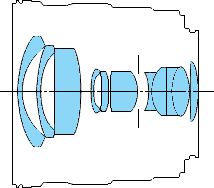
Internal diagram.
11 spherical elements in 9 groups.
Multicoated.
Rear focus.
Focal Length
20mm.
Used on a 1.3x camera, it will see about the same field of view as a 26mm lens sees on full-frame — so why bother?
Used on a 1.6x camera, it will see about the same field of view as a 30mm lens sees on full-frame — so why bother?
Angle of View (on 35mm and full-frame cameras)
94º diagonal.
62º vertical.
84º horizontal.
Close Focus top
0.82 feet (10" or 0.25 m) from the image plane, specified.
0.75 feet (9" or 0.23 m) from the image plane, measured.
Maximum Reproduction Ratio top
1:7.1 (0.14x).
With EF12 tube: 1:1.4 (0.72x). (won't work with EF25 tube).
Minimum Subject Field top
6.9 x 10.4" (176 x 264 mm), no extension tube.
Diaphragm top
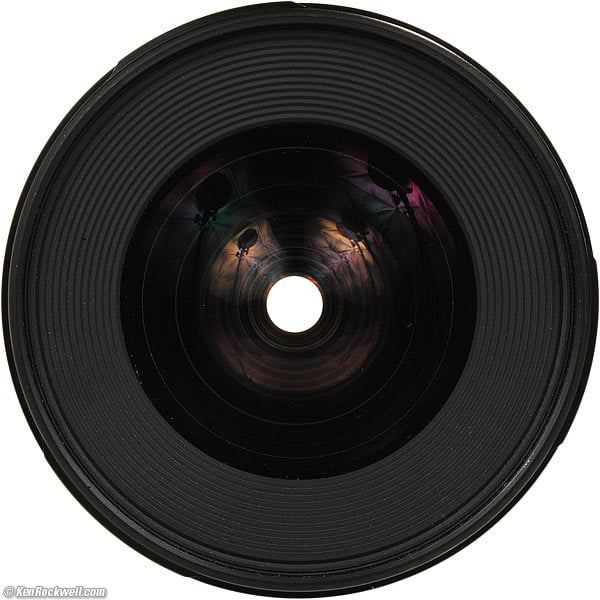
Front, Canon 20mm at f/2.8 USM at f/2.8.
6 blades.
Stops down to f/22.
Canon's 1992 literature claims 5 blades. I can't confirm if this is a misprint, or if early models really did have 5 blades.
Focus Scale top
Yes.
The ring turns from infinity to the closest focus distance in about 80.º
Depth-of-Field Scale top
Yes.
Infra-Red Focus Indices top
Yes, red dot for 800 nm wavelength.
Filters top
72mm thread, metal.
Never moves.
Size top
Canon specifies 3.1" (77.5mm) diameter by 2.8" (70.6 mm) long.
Nothing moves externally as autofocused.
Weight top
13.895 oz. (394.0g), measured.
Canon specifies 14.2 oz. (405g).
EW-75II plastic hood weighs 0.845 oz. (24.0 g).
Hood top
Canon EW-75II hood.
Plastic bayonet EW-75II, optional.
It's the same hood as used by the 20-35mm f/2.8 L.
Case top
LP1214 sack, $25.
LH-C13 hard case.
Caps top
Standard EOS cap rear.
Quality top
Made in Japan.
Introduced top
June, 1992.
Price, USA top
2012 July: $500 new or $325 used.
Performance top
Intro Specs Performance Compared Recommendations More
Overall Autofocus Breathing Color Distortion Ergonomics
Falloff Filters Flare Lateral Color Fringes
Macro Mechanics Sharpness Sunstars
Overall performance top
The Canon 20mm f/2.8 USM is a small, light very well-made and optically and ergonomically excellent lens for practical full-frame ultrawide photography, especially with a lens profile on the 5D Mark III.
This review is based on one random sample of indeterminate age I purchased from some stranger over eBay. If you buy a new one, it might be even better.
Autofocus performance top
Autofocus is nearly instantaneous and silent. No surprises here from Canon!
Auto/Manual Switching
Just grab the focus ring for instant manual-focus override.
You never need to touch the AF-MF switch unless you want to lock-out autofocus.
AF Speed
AF is virtually instantaneous
AF Accuracy and Consistency
AF accuracy is fine on my Canon 5D Mark III.
Manual Focus
Manual focus is easy; just move the ring.
Focus Breathing performance top
Focus breathing is of interest to cinematographers who don't want the image changing size ("breathing") as the lens is focused among different subjects.
The image of the Canon 20mm f/2.8 USM gets larger as focused more closely.
Color Rendition performance top
The color balance of this 20mm f/2.8 matches my other Canon EF lenses.
Distortion performance top
This Canon 20/2.8 USM has the usual complex distortion seen in other 20mm ultrawide SLR lenses. It's much less than in zooms at their wide extremes.
Specifically, the 20 USM has complex distortion which bulges-out in the center, pinches-in the zonal areas a little, and then stretches-out again in the corners.
Straight lines near the frame edge along the long picture dimension wiggle, with the corners and middle touching the frame edge, and the to halfway-out-to-the-corners spots pulling in from the edge.
Straight lines near the frame edge along the short picture dimension are straight, or curve in a little.
Photoshop's Lens Distortion tool is too simple to be able to remove this complex distortion; leave this tool set to zero.
If shot on the Canon 5D Mark III as a raw file with the appropriate lens profile loaded, the 5D Mark III can process raw files in-camera to eliminate all of this distortion.The camera cannot eliminate this distortion as-shot. Canon's computer software and DxO also ought to be able to fix this, but I haven't tried.
Ergonomics performance top
Canon 20/2.8. enlarge.
Ergonomics are perfect, just grab and go.
The manual focus ring is easy to slide with a fingertip for one-handed shooting.
Falloff (darkened corners) performance top
Shot on modern full-frame cameras with peripheral illumination correction enabled, there is no significant falloff.
Shot on 35mm film or with full-frame digital cameras without peripheral illumination correction, there is strong falloff at f/2.8, it's much improved at f/4, and gone by f/5.6.
I've greatly exaggerated this below by shooting a flat gray target and presenting these images against a flat gray background:
Canon 20mm f/2.8 USM falloff on full-frame No peripheral illumination correction
© 2012 KenRockwell.com. All rights reserved.
Peripheral illumination correction enabled
© 2012 KenRockwell.com. All rights reserved.
|
Filters, Use with performance top
There is no vignetting on full-frame, even with thick rotating 72mm filters like my Schneider 0.6 grad ND (8.6mm thick excluding rear threads).
There is no vignetting on full-frame, even with two stacked normal filters (9.6mm total ring thickness excluding rear threads).
Anything thicker than this, or three stacked filters, and you're going to get vignetting on full-frame.
Filter vignetting is worst at infinity and worst at f/2.8. Stop down or focus closer and it gets better if you're on the hairy edge.
Don't use polarizers on ultrawide lenses, they make the sky look funny.
Flare and Ghosts performance top
The 20 has a classic amount of ghosts. There are none for normal use, but get the sun in your image, and you'll get just the right amount.
This is as bad as I could make it look, and this is with a single-coated UV filter over the lens:
Ghosts. Canon 20/2.8 USM on full-frame, f/10 at 1/400 at ISO 100 on 5D Mk III. bigger.
Lateral Color Fringes performance top
There are no color fringes when shot with a lens profile on the 5D Mk III.
Without a profile, or on 35mm film like Fuji Velvia 50, there are some minor magenta/green fringes. This is much better than the 20-35mm f/2.8 L and 20-35mm USM. It's about as good as the 16-35mm f/2.8 L II and 17-40mm f/4 L, maybe better!
Macro performance top
Macro isn't that great, which is as expected for any ultrawide lens.
At close-focus distance, f/9 at 1/320 at ISO 100, full-frame Canon 5D Mark III.
I'm so close (9" or 23 cm) that it makes my watch look big and my arm look small.
Shot on Canon's smaller-format 1.3x and 1.6x cameras, the effect will be even closer.
Crop from above image at 100%, 22 MP Canon 5D Mark III.
Mechanics performance top
Rear, Canon 20 f/2.8 USM. enlarge.
The Canon 20mm f/2.8 USM is a professional lens, better made than most of Canon's more expensive lenses today.
Filter Threads
Machined billet aluminum, black anodized.
Hood Mount
Machined billet aluminum, black anodized.
Fore Barrel
Metal.
Focus Ring
Plastic, covered with rubber.
Mid-barrel
Plastic.
Internals
Metal and plastic.
Moisture seal at mount
No.
Mount
Chromed metal.
Markings
Paint.
Serial Number
Laser-engraved into rear black light baffle (only visible with uncapped lens removed from camera).
Date Code
None found.
Noises When Shaken
Mild clicking.
Made in
Japan, for the hood and caps as well as the lens.
Sharpness performance top
The Canon 20mm is super-sharp when used properly. It's even sharper than the 16-35mm f/2.8 L II in the corners!
Used improperly, which means shot on a 1.6x camera or used to shoot flat targets, it's unsharp in the zonal region, meaning the part of the full-frame image about halfway out between the center and the corners of full frame. (used on 1.6x cameras, the zonal region becomes the corners, which gets nasty.)
It seems unsharp in the zonal regions with flat targets because its surface of optimum focus is deliberately optimized (curved) to favor subjects that are closer in the zonal areas. When used for landscapes or interiors, this renders the side walls, floors and ceilings (or the ground) in much sharper focus than would a flat-field lens.
Canon uses field curvature for this ultrawide. It doesn't do this for longer lenses, because longer lenses aren't used for shooting the same subjects as ultrawides.
The surface of optimum focus comes-in at the sides on full-frame, but goes back out again at the very corners.
Ryan lifts a Mercedes. (Canon 5D Mark III, Canon 20mm f/2.8 USM, f/8 at 1/320, AUTO ISO 100, 6 sharpening, 0 saturation, AUTO WB A4.) bigger.
In this shot, I had Ryan in the center, and the car headlight was on the right (the left was cropped-off). As usual for this sort of shot, the car headlight was closer, and brought into perfect focus by the Intelligent Field Curvature.
Library. (Canon 5D Mark III, Canon 20mm f/2.8 USM, f/11 at 1/160, AUTO ISO 100, 6 sharpening, 0 saturation, AUTO WB A4.) Original © 7.4 MB file.
Ditto for this shot of the library: as the wall gets closer at the side, it stays super-sharp. Note how the far wall in the center is in focus, as well as the closer wall to the left. It's all in perfect focus, while the far-away wall in the distance on the right isn't. The Intelligent Field Curvature (IFC) put what we need to be sharp, the closest and middle-ground items, in perfect focus, and let the distant irrelevancies get softer. If you know How to Use Ultrawide Lenses, you know ultrawides are all about getting close for emphasis, and trying to soften far-way items to emphasize the 3-dimensional effect. Brilliant!
By aperture, the 20/2.8 is amazingly sharp even at f/2.8, if you're in focus. Even the corners are sharp, which is better than any of Canon's ultrawide zooms. The center is always sharp and contrasty at every aperture.
The corners are sharp, but a bit less contrasty at f/2.8. Their contrast picks up as stopped down, becoming excellent by f/5.6 and even a little better at f/8 and f/11.
If you're shooting something silly, like going on top of a mountain and looking down so that everything is it infinity (how I usually test lenses, but not how I make good pictures), the zonal areas will be softer wide-open, and optimum at f/11 and f/16. For real shots where objects in these areas are closer than the rest of the image, the zonal areas are sharp.
If softens from diffraction at 22.
Here is Canon's rated MTF curve:

Canon 20mm f/2.8 USM MTF.
Sunstars performance top
Six-Pointed Sunstar. Canon 20/2.8 USM on full-frame 5D Mk III, f/10 at 1/400 at ISO 100. bigger.
With an ordinary 6-bladed diaphragm, sunstars are common 6-pointed ones, visible at many apertures, on brilliant points of light.
If older versions of this lens from 1992 have 5-bladed diaphragms, those would make 10-pointed sunstars.
Compared top
Intro Specs Performance Compared Recommendations More
Canon 20/2.8 USM, 17-40/4 L, 16-35/2.8 L II and 16-35/4 L IS. bigger.
NEW: Canon Ultrawide Lens Sharpness Comparison.
Canon Ultrawide Lenses Compared
Recommendations top
Intro Specs Performance Compared Recommendations More
This 20mm is an excellent lens, often overlooked because most people can't look past big, heavy expensive zooms. This 20 USM makes pictures at least as good, is much easier to carry, and costs less. It's easily available both new and used.
If you've found the time I've spent sharing this professional review helpful, this free website's biggest source of support is when you use these links, especially these links directly to it at Adorama, at Amazon or at eBay (see How to Win at eBay), when you get anything, regardless of the country in which you live.
Thanks!
Ken
More Information top
Intro Specs Performance Compared Recommendations More
Canon's 20mm USM product page.
Another version of the Canon instruction manual.
Help me help you top
I support my growing family through this website, as crazy as it might seem.
The biggest help is when you use any of these links when you get anything, regardless of the country in which you live. It costs you nothing, and is this site's, and thus my family's, biggest source of support. These places have the best prices and service, which is why I've used them since before this website existed. I recommend them all personally.
If you find this page as helpful as a book you might have had to buy or a workshop you may have had to take, feel free to help me continue helping everyone.
If you've gotten your gear through one of my links or helped otherwise, you're family. It's great people like you who allow me to keep adding to this site full-time. Thanks!
If you haven't helped yet, please do, and consider helping me with a gift of $5.00.
As this page is copyrighted and formally registered, it is unlawful to make copies, especially in the form of printouts for personal use. If you wish to make a printout for personal use, you are granted one-time permission only if you PayPal me $5.00 per printout or part thereof. Thank you!
Thanks for reading!
Mr. & Mrs. Ken Rockwell, Ryan and Katie.
Home Donate New Search Gallery Reviews How-To Books Links Workshops About Contact
